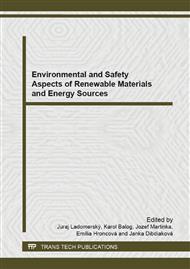[1]
E. Ružinská: Plastics and Coating Materials in Woodworking Industry (in Slovak). Monography. Edit. Technical University Publ. Zvolen, 199 p. ISBN 80-228-1518-7 (2005).
Google Scholar
[2]
P. Boruszewski, M. Mamiński, E. Ružinská,: Raw materials and Particleboard – a current status and perspectives. Monography. WULS- SGGW Warsaw, 111 p. ISBN 978-83-7583-389-8 (2012).
Google Scholar
[3]
M. Jablonski, E. Ružinská, M. Swietliczny: Synthetic polymers and coatings in woodworking industry (in Poland). Textbook. Edt. WULS- SGGW Warsaw, 247 p. ISBN 978-83-7583-044-6 (2009).
Google Scholar
[4]
E. Ružinská: The study of thermal characteristics of modified products isolated form kraft black liquor for formulation of new type of adhesive mixture. Wood Research, 48, No. 1/2, pp.22-35. ISSN 0012-6136 (2013).
Google Scholar
[5]
J. Martinka, T. Chrebet, J. Kráľ, K. Balog: An examination of the behavior of thermally treated spruce wood under fire conditions. Wood Research, 58, No. 4, pp.599-606 . ISSN 0012-6136 (2013).
Google Scholar
[6]
T. Chrebet, J. Martinka, T., K. Balog, I. Hrušovský: Moment of Lignocellulosic Materials Ignition Defined by Critical Mass Flow Rate. Applied Mechanics and Materials, Vol. 291-294, pp.1985-1988. (2013).
DOI: 10.4028/www.scientific.net/amm.291-294.1985
Google Scholar
[7]
E. Ružinská, M. Jablonski: Thermal characteristics of components for preparation of environmental wood based composites in aspect of fire safety. Annals of Warsaw University of Life Sciences – SGGW, No. 64, pp.232-237. ISSN 1898-5912. (2008).
Google Scholar
[8]
E. Ružinská, I. Mitterová, J. Osipiuk: Proposal of the experimental determination of selected characteristics of the thermal degradation of wood material modified by coatings with the occurrence of risk substances. Annals of Warsaw University of Life Sciences – SGGW, No. 84, pp.116-120. ISSN 1898-5912 (2013).
Google Scholar
[9]
M. Zachar, I. Mitterová, Q. Xu., A. Majlingová, C. Jin, Š. Galla: Determination fire and burning properties of the spruce wood. Drwna Industrija, Zagreb. Šumarski fakultet Sveučilišta u Zagrebu, pp.217-223. ISSN 0012-6772. (2012).
DOI: 10.5552/drind.2012.1141
Google Scholar


